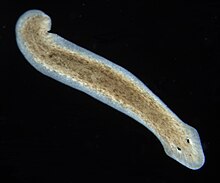The article's lead section may need to be rewritten. The reason given is: it does not summarise the body. (December 2023) |
| Planarian | |
|---|---|

| |
| Dugesia subtentaculata, a dugesiid. | |
| Scientific classification | |
| Domain: | Eukaryota |
| Kingdom: | Animalia |
| Phylum: | Platyhelminthes |
| Subphylum: | Rhabditophora |
| Order: | Tricladida Lang, 1884 |
| Subdivis[1] | |
| |
Planarians (triclads) are free-living flatworms of the class Turbellaria,[2][3] order Tricladida,[4] which includes hundreds of species, found in freshwater, marine, and terrestrial habitats.[5] Planarians are characterized by a three-branched intestine, including a single anterior and two posterior branches.[5] Their body is populated by adult stem cells called neoblasts, which planarians use for regenerating missing body parts.[6] Many species are able to regenerate any missing organ, which has made planarians a popular model in research of regeneration and stem cell biology.[7] The genome sequences of several species are available, as are tools for molecular biology analysis.[7][8]
The order Tricladida is split into three suborders, according to their phylogenetic relationships: Maricola, Cavernicola and Continenticola. Formerly, the Tricladida was split according to their habitat: Maricola (marine planarians); Paludicola (freshwater planarian); and Terricola (land planarians).[9]
Planarians move by beating cilia on the ventral dermis, allowing them to glide along on a film of mucus. Some also can move by undulations of the whole body by the contractions of muscles built into the body membrane.[10]
Triclads play an important role in watercourse ecosystems and are often very important as bio-indicators.[11]
- ^ Sluys, R.; Kawakatsu, M.; Riutort, M.; Baguñà, J. (2009). "A new higher classification of planarian flatworms (Platyhelminthes, Tricladida)". Journal of Natural History. 43 (29–30): 1763–1777. Bibcode:2009JNatH..43.1763S. doi:10.1080/00222930902741669. S2CID 85174457.
- ^ "Planarian (flatworm) – Britannica Online Encyclopedia". Encyclopædia Britannica, Inc. Retrieved 2010-05-01.
- ^ Campbell NA, Reece JB (2019). Biology. Benjamin Cummings. pp. 1230 pp. ISBN 978-0-8053-7146-8.
- ^ "Tricladida". Integrated Taxonomic Information System. Retrieved July 23, 2007.
- ^ a b Sluys, Ronald; Riutort, Marta (2018), Rink, Jochen C. (ed.), "Planarian Diversity and Phylogeny", Planarian Regeneration: Methods and Protocols, Methods in Molecular Biology, vol. 1774, New York, NY: Springer, pp. 1–56, doi:10.1007/978-1-4939-7802-1_1, ISBN 978-1-4939-7802-1, PMID 29916154, retrieved 2023-12-02pp 3., "Planarians (the popular name for the group as a whole), or triclad flatworms (the more scientific designation of the same group), are acoelomate bilaterians".
- ^ Vila-Farré, Miquel; Rozanski, Andrei; Ivanković, Mario; Cleland, James; Brand, Jeremias N.; Thalen, Felix; Grohme, Markus A.; von Kannen, Stephanie; Grosbusch, Alexandra L.; Vu, Hanh T.-K.; Prieto, Carlos E.; Carbayo, Fernando; Egger, Bernhard; Bleidorn, Christoph; Rasko, John E. J. (2023-10-19). "Evolutionary dynamics of whole-body regeneration across planarian flatworms". Nature Ecology & Evolution. 7 (12): 2108–2124. doi:10.1038/s41559-023-02221-7. ISSN 2397-334X. PMC 10697840. PMID 37857891. S2CID 264347538.
- ^ a b Newmark PA, Sánchez Alvarado A (March 2002). "Not your father's planarian: a classic model enters the era of functional genomics". Nature Reviews. Genetics. 3 (3): 210–9. doi:10.1038/nrg759. PMID 11972158. S2CID 28379017.
- ^ Rozanski, Andrei; Moon, HongKee; Brandl, Holger; Martín-Durán, José M; Grohme, Markus A; Hüttner, Katja; Bartscherer, Kerstin; Henry, Ian; Rink, Jochen C (2019-01-08). "PlanMine 3.0—improvements to a mineable resource of flatworm biology and biodiversity". Nucleic Acids Research. 47 (D1): D812–D820. doi:10.1093/nar/gky1070. ISSN 0305-1048. PMC 6324014. PMID 30496475.
- ^ Hallez P. (1892). Classification des Ticlades, Bulletin de la Société Zoologique de France.
- ^ Rompolas P, Patel-King RS, King SM (2009). Schmidtea mediterranea: a model system for analysis of motile cilia. Methods in Cell Biology. Vol. 93. pp. 81–98. doi:10.1016/S0091-679X(08)93004-1. ISBN 9780123813770. PMID 20409812.
- ^ Manenti R (2010). "– Effect of landscape features and water quality on Triclads inhabiting head waters: the example of Polycelis felina" (PDF). Revue Écologie Terre et Vie. 65 (2): 279–285. doi:10.3406/revec.2010.1533. hdl:2434/147984. S2CID 54499235.